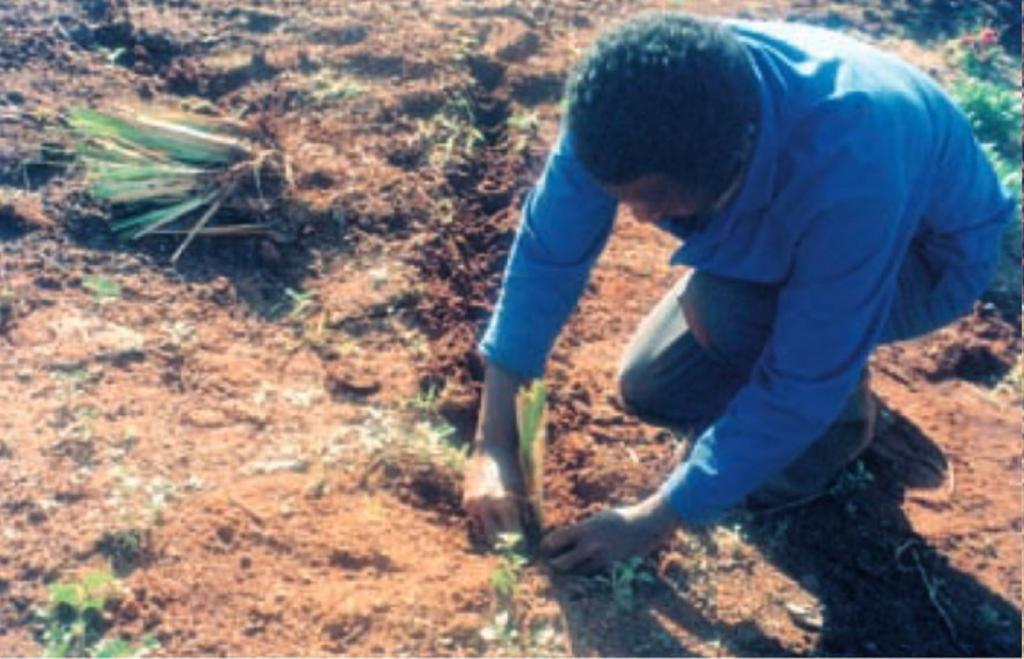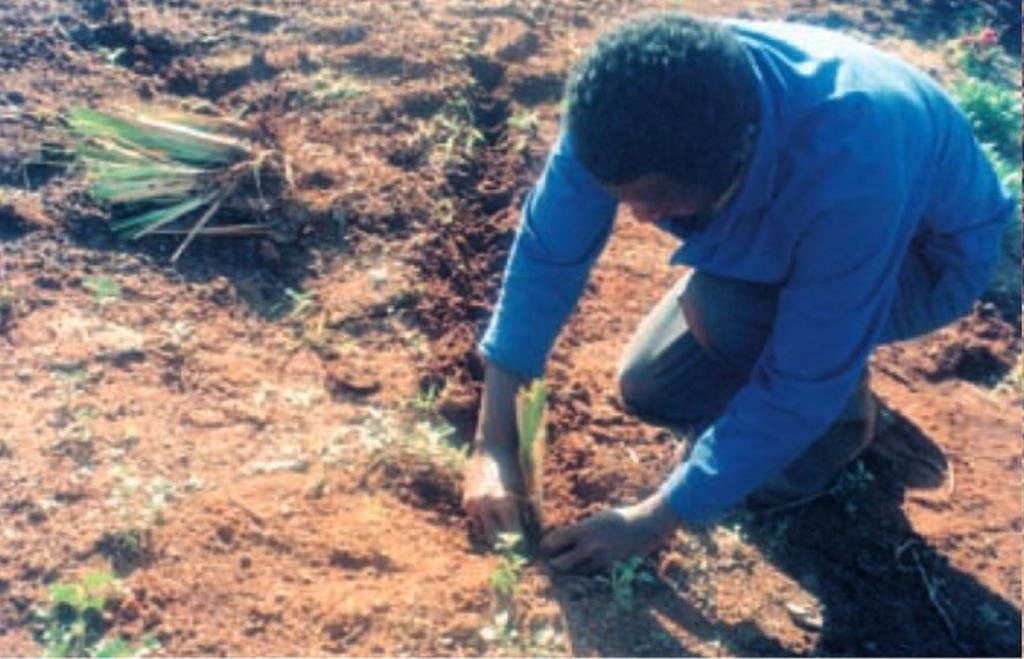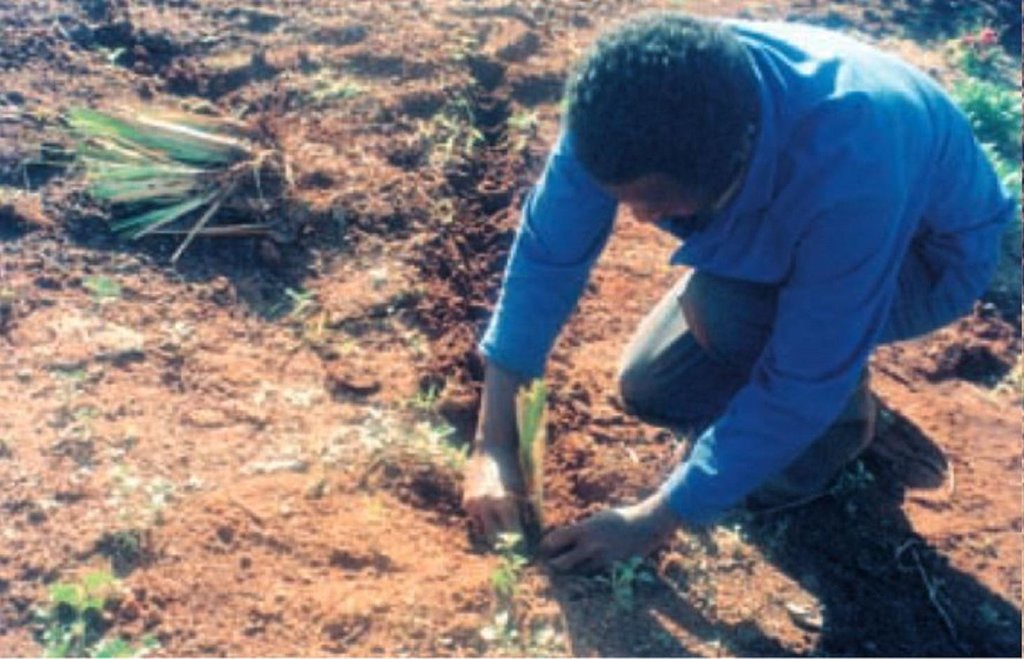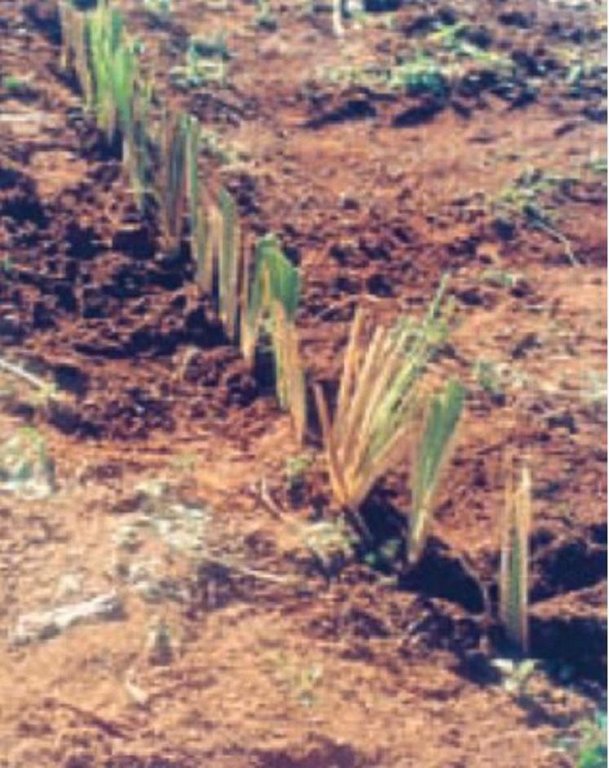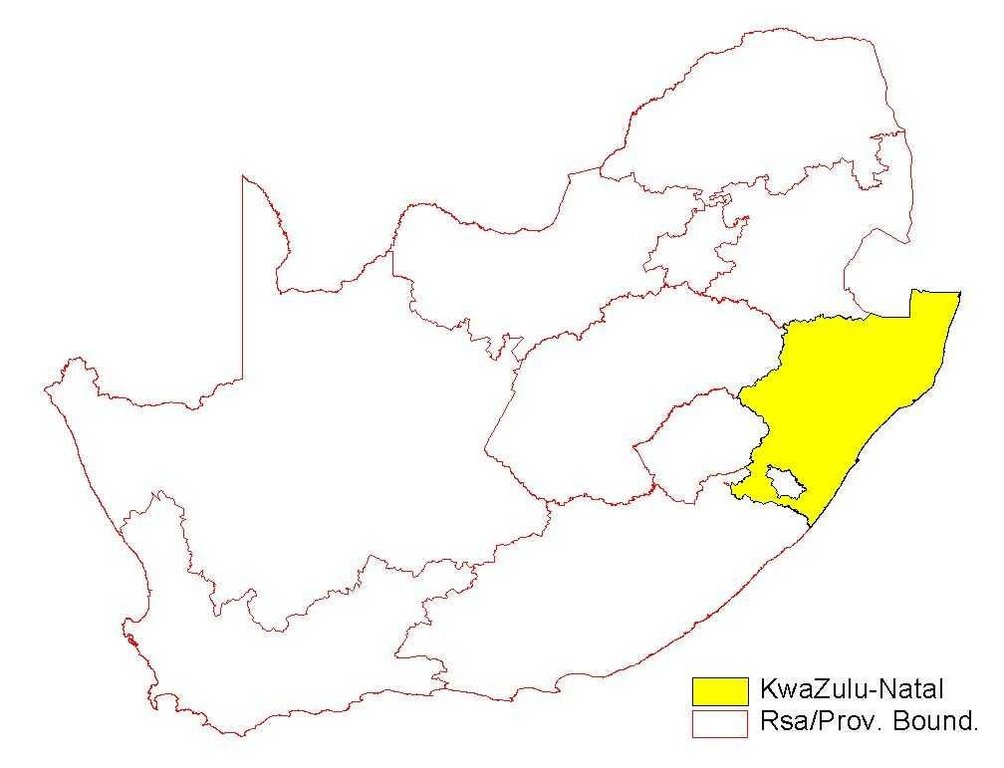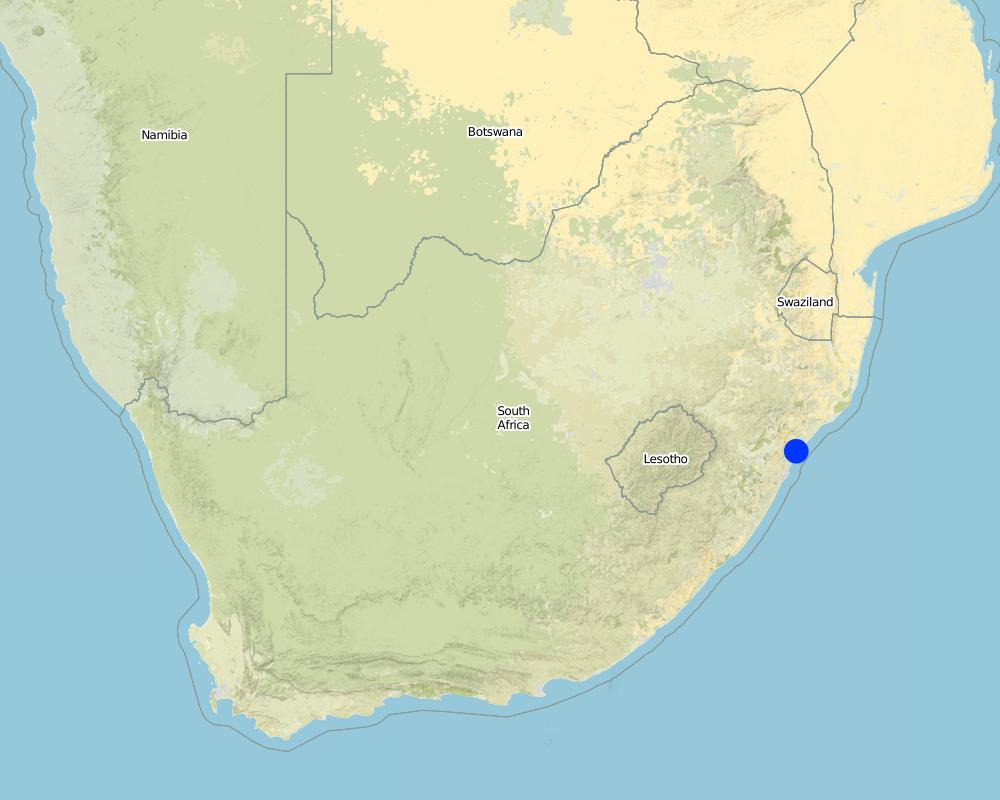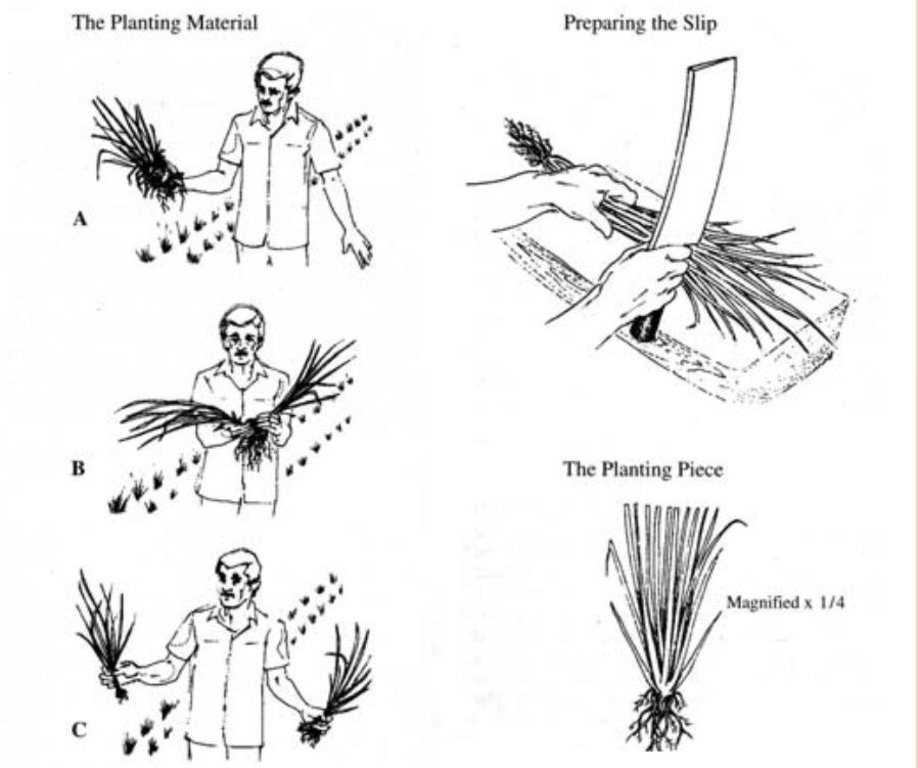Self teaching [แอฟริกาใต้]
- ผู้สร้างสรรค์:
- การอัพเดท:
- ผู้รวบรวม: Philippe Zahner
- ผู้เรียบเรียง: –
- ผู้ตรวจสอบ: Fabian Ottiger, Deborah Niggli
approaches_2611 - แอฟริกาใต้
ดูส่วนย่อย
ขยายทั้งหมด ย่อทั้งหมด1. ข้อมูลทั่วไป
1.2 รายละเอียดที่ติดต่อได้ของผู้รวบรวมและองค์กรที่เกี่ยวข้องในการประเมินและการจัดเตรียมทำเอกสารของแนวทาง
ผู้เชี่ยวชาญ SLM:
van der Merwe Rinda
rinda@arc.agric.za
Institute for Soil, Climate and Water
P/Bag x79, 0001 Pretoria
แอฟริกาใต้
ชื่อของโครงการซึ่งอำนวยความสะดวกในการทำเอกสารหรือการประเมินแนวทาง (ถ้าเกี่ยวข้อง)
Book project: where the land is greener - Case Studies and Analysis of Soil and Water Conservation Initiatives Worldwide (where the land is greener)ชื่อของโครงการซึ่งอำนวยความสะดวกในการทำเอกสารหรือการประเมินแนวทาง (ถ้าเกี่ยวข้อง)
Swiss Agency for Development and Cooperation (DEZA / COSUDE / DDC / SDC) - สวิตเซอร์แลนด์ชื่อของโครงการซึ่งอำนวยความสะดวกในการทำเอกสารหรือการประเมินแนวทาง (ถ้าเกี่ยวข้อง)
Institute for Soil, Climate & Water - แอฟริกาใต้1.3 เงื่อนไขที่เกี่ยวข้องกับการใช้ข้อมูลที่ได้บันทึกไว้ผ่านทาง WOCAT
ผู้รวบรวมและวิทยากรหลักยอมรับเงื่อนไขเกี่ยวกับการใช้ข้อมูลที่ถูกบันทึกผ่านทาง WOCAT:
ใช่
1.4 การอ้างอิงถึงแบบสอบถามเรื่องเทคโนโลยี SLM
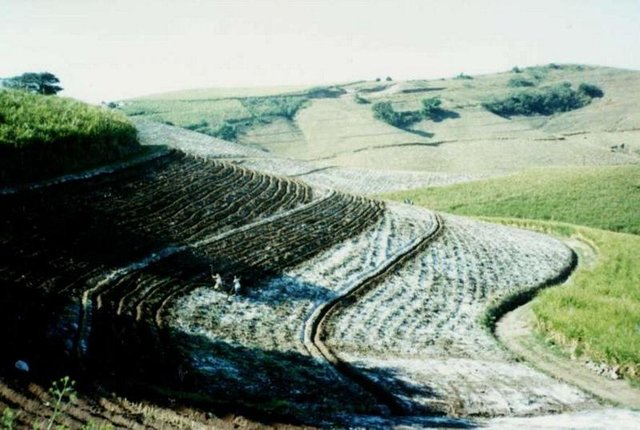
Vetiver grass soil conservation system [แอฟริกาใต้]
Contour lines of vetiver grass planted within fields of sugar cane, on stream banks and roadsides, to act as ‘hedges against erosion’.
- ผู้รวบรวม: Unknown User
2. คำอธิบายของแนวทาง SLM
2.1 การอธิบายแบบสั้น ๆ ของแนวทาง
Learning how to use vetiver grass as a vegetative conservation barrier through instructions from a booklet and hands-on practical experience.
2.2 การอธิบายอย่างละเอียดของแนวทาง
การอธิบายอย่างละเอียดของแนวทาง:
Aims / objectives: The manager of the farm was given a book and video on vetiver grass by the Mazda group from UK. His objective was to teach himself to improve his conservation system. Already he had a number of consercation strategies, including terracing, minimum tillage, mulching and strip-cropping, but he felt there was a need to better his syste,. Through self-teaching he gave himself an oppurtunity to do so.
There had been some vetiver plants on the farm for 40 years, and it held the soil in place where it grew. This vetiver grew into huge clumps comprising many splits (tillers). The book demonstrated how vetiver could be dug up, split and planted in a continuous barrier hedge for soil and water conservation. In other words, the book offered the possibility of improving on what was already there.
The approach therefore was to take ideas from a book, testing those ideas and see how they worked in practice. The approach has developed further by the farmer spreading his message to neighbours, some of whom have copied the system after visiting his farm and seeing the results for themselves. While the original handbook had been aimed especially at Indian farmers, subsequent to the successful experience of this particular farmer, a locally focussed handbook has been recently prepared in English and Zulu by the South African Vetiver Network.
2.3 รูปภาพของแนวทาง
2.5 ประเทศ ภูมิภาค หรือสถานที่ตั้งที่ได้นำแนวทางไปใช้
ประเทศ:
แอฟริกาใต้
ภูมิภาค/รัฐ/จังหวัด: :
Kwa-Zulu Natal
ข้อมูลเฉพาะเพิ่มเติมของสถานที่ตั้ง:
Lower Tugela District, South Africa
Map
×2.6 วันที่เริ่มต้นและสิ้นสุดของแนวทาง
ระบุปีที่เริ่ม:
1989
2.8 เป้าหมายหรือวัตถุประสงค์หลักของแนวทาง
The Approach focused on SLM only
test and try a new method by self-teaching and gaining hands-on experience
The SLM Approach addressed the following problems: lack of knowledge about alternative conservation technologies, need for a new and cheap supplement to existing forms of soil and water conservation within sugar cane, that could be tested and tried by the farmer himself without need for outside advice.
2.9 เงื่อนไขที่เอื้ออำนวยหรือเป็นอุปสรรคต่อการนำเทคโนโลยีภายใต้แนวทางนี้ไปปฏิบัติใช้
การมีไว้ให้หรือการเข้าถึงแหล่งการเงินและบริการ
- เป็นอุปสรรค
Need to find a cheap supplement to existing SWC in sugar cane
Treatment through the SLM Approach: Discovery of vetiver grass barrier hedge technology described in a booklet
กรอบแนวทางในการดำเนินการด้านกฎหมาย (การถือครองที่ดิน สิทธิในการใช้ที่ดินและน้ำ)
- เอื้ออำนวย
The existing land ownership, land use rights / water rights greatly helped the approach implementation: Made own decision and started to implement immediately
3. การมีส่วนร่วมและบทบาทของผู้มีส่วนได้ส่วนเสียที่เกี่ยวข้อง
3.1 ผู้มีส่วนได้ส่วนเสียที่เกี่ยวข้องในแนวทางนี้และบทบาท
- ผู้ใช้ที่ดินระดับท้องถิ่นหรือชุมชนระดับท้องถิ่น
Working land users were mainly men (Also women, the men are used for more physical work (harder))
3.2 การเกี่ยวข้องของผู้ใช้ที่ดินระดับท้องถิ่นหรือชุมชนระดับท้องถิ่นในช่วงต่างๆของแนวทาง
| ความเกี่ยวข้องของผู้ใช้ที่ดินระดับท้องถิ่นหรือชุมชนระดับท้องถิ่น | ระบุผู้ที่มีส่วนเกี่ยวข้องและอธิบายกิจกรรม | |
|---|---|---|
| การริเริ่มหรือการจูงใจ | ระดมกำลังด้วยตนเอง | looking for ideas |
| การวางแผน | ระดมกำลังด้วยตนเอง | reading and thinking through the possibilities |
| การดำเนินการ | ระดมกำลังด้วยตนเอง | paying farm labourers to plant the grass |
| การติดตามตรวจสอบหรือการประเมินผล | ระดมกำลังด้วยตนเอง | observation |
| Research | ไม่มี | not applicable |
3.3 แผนผังแสดงขั้นตอนการทำงาน (ถ้ามี)
คำอธิบาย:
Establishing vetiver hedges: instructions on preparation for planting in the vetiver handbook.
ผู้เขียน:
World Bank, 1990
3.4 การตัดสินใจเลือกใช้เทคโนโลยี SLM
ระบุผู้ที่ทำการตัดสินใจเลือกเทคโนโลยีมากกว่าหนึ่งวิธีไปปฏิบัติใช้:
- ผู้ใช้ที่ดินเพียงผู้เดียว ( ริเริ่มด้วยตัวเอง)
การอธิบาย:
land user driven (bottom-up). Literature
Decisions on the method of implementing the SLM Technology were made by by land users* alone (self-initiative / bottom-up). land user driven (bottom-up).
4. การสนับสนุนด้านเทคนิค การสร้างขีดความสามารถ และการจัดการด้านความรู้
4.1 การสร้างขีดความสามารถ / การอบรม
ได้มีการจัดอบรมให้แก่ผู้ใช้ที่ดินหรือผู้มีส่วนได้ส่วนเสียคนอื่น ๆ หรือไม่:
ใช่
ให้ระบุว่าใครเป็นผู้ได้รับการอบรม:
- ผู้ใช้ที่ดิน
ถ้าเกี่ยวข้อง ให้ระบุ เพศ อายุ สถานภาพ ชาติพันธุ์ เป็นต้น:
self-taught through use of World Bank's vetiver handbook
รูปแบบการอบรม:
- self-taught, hands-on experience
4.4 การติดตามตรวจสอบและประเมินผล
การติดตามตรวจสอบและประเมินผลเป็นส่วนหนึ่งของแนวทางหรือไม่:
ใช่
ความคิดเห็น:
bio-physical aspects were regular monitored by land users through observations; indicators: vetiver performance
technical aspects were ad hoc monitored by land users through observations
economic / production aspects were ad hoc monitored by land users through observations
area treated aspects were regular monitored by land users through measurements
no. of land users involved aspects were ad hoc monitored by land users through observations
There were no changes in the Approach as a result of monitoring and evaluation
There were no changes in the Technology as a result of monitoring and evaluation
5. การสนับสนุนด้านการเงินและวัสดุอุปกรณ์
5.1 ระบุงบประมาณประจำปีสำหรับแนวทาง SLM นี้
แสดงความคิดเห็น (แหล่งของการระดมทุน ผู้บริจาคคนสำคัญ):
Approach costs were met by the following donors: other (farmer itself): 100.0%
5.2 การสนับสนุนด้านการเงิน / วัสดุอุปกรณ์ให้แก่ผู้ใช้ที่ดิน
ผู้ใช้ที่ดินได้รับการสนับสนุนด้านการเงิน / วัสดุอุปกรณ์ไปปฏิบัติใช้เทคโนโลยีหรือไม่:
ไม่ใช่
5.3 เงินสนับสนุนสำหรับปัจจัยนำเข้า (รวมถึงแรงงาน)
ถ้าแรงงานโดยผู้ใช้ที่ดินเป็นปัจจัยนำเข้าที่มีอยู่มากมาย ระบุด้วยว่าเนื่องจาก:
- สมัครใจ
5.4 เครดิต
มีการจัดหาเครดิตมาให้ภายใต้แนวทาง SLM หรือไม่:
ไม่ใช่
6. การวิเคราะห์ผลกระทบและการสรุป
6.1 ผลกระทบของแนวทาง
ช่วยให้ผู้ใช้ที่ดินนำเอาเทคโนโลยี SLMไปใช้และบำรุงรักษาสภาพไว้ได้หรือไม่:
- ไม่ใช่
- ใช่ เล็กน้อย
- ใช่ ปานกลาง
- ใช่ อย่างมาก
Land users can continue without support and at least a modest spontaneous expansion of adoption is expected.
Did other land users / projects adopt the Approach?
- ไม่ใช่
- ใช่ เล็กน้อย
- ใช่ ปานกลาง
- ใช่ อย่างมาก
Three neighbouring farmers have adopted the technology throught their observations
6.3 ความยั่งยืนของกิจกรรมของแนวทาง
ผู้ใช้ที่ดินสามารถทำให้สิ่งต่างๆ ที่ได้ปฏิบัติใช้โดยแนวทางนี้ยั่งยืนได้หรือไม่ (โดยไม่มีการสนับสนุนจากภายนอก):
- ใช่
ถ้าตอบว่าใช่ ให้อธิบายว่าอย่างไร :
Land users can continue without support and at least a modest spontaneous expansion of adoption is expected.
6.4 จุดแข็งและข้อได้เปรียบของแนวทาง
| จุดแข็ง / ข้อได้เปรียบของแนวทางในทัศนคติของผู้ใช้ที่ดิน |
|---|
| Neighbours can easily see and copy (How to sustain/ enhance this strength: Farmer-to-farmer visits could be promoted through self-help groups and associations.) |
| A very cheap method of extension/knowledge transfer (How to sustain/ enhance this strength: Produce and disseminate booklets and information on the internet more widely.) |
| จุดแข็ง / ข้อได้เปรียบของแนวทางในทัศนคติของผู้รวบรวมหรือวิทยากรหลัก |
|---|
| A technical system devised from a handbook and experience rather than needing a project or intensive visits from extension agents (How to sustain/ enhance this strength: Make sure such handbooks are spread and available in local languages.) |
6.5 จุดอ่อน / ข้อเสียเปรียบของแนวทางและวิธีในการแก้ไข
| จุดอ่อน / ข้อเสียเปรียบในทัศนคติของผู้รวบรวมหรือวิทยากรหลัก | สามารถแก้ไขปัญหาได้อย่างไร |
|---|---|
| Not everyone has access to such teaching material or is literate | Spread literature and information more widley and in local languages both in written form and on the radio. |
7. การอ้างอิงและการเชื่อมต่อ
7.1 วิธีการหรือแหล่งข้อมูล
- ไปเยี่ยมชมภาคสนาม การสำรวจพื้นที่ภาคสนาม
- การสัมภาษณ์กับผู้ใช้ที่ดิน
7.2 การอ้างอิงถึงสิ่งตีพิมพ์
ชื่อเรื่อง ผู้เขียน ปี ISBN:
World Bank (1990): Vetiver Grass: The Hedge against Erosion
ช่องทางในการสืบค้น และราคา:
World Bank, Washington D.C.
ลิงก์และโมดูล
ขยายทั้งหมด ย่อทั้งหมดลิงก์

Vetiver grass soil conservation system [แอฟริกาใต้]
Contour lines of vetiver grass planted within fields of sugar cane, on stream banks and roadsides, to act as ‘hedges against erosion’.
- ผู้รวบรวม: Unknown User
โมดูล
ไม่มีโมดูล


